Mon 26 Aug 2019
A Book! Movie!! Review by Dan Stumpf: DONALD HAMILTON – The Steel Mirror / FIVE STEPS TO DANGER (1957).
Posted by Steve under Action Adventure movies , Reviews[4] Comments
DONALD HAMILTON – The Steel Mirror. Rinehart & Co., 1948. Paperback reprints include: Dell #473, 1950; Gold Medal d1617, 1966.
FIVE STEPS TO DANGER. Henry S. Kesler Productions/Unoted Artists, 1957. Ruth Roman, Sterling Hayden, Werner Kemperer, Jeanne Cooper and Karl Lindt. Written & directed by Henry S. Kesler, from the novel by Donald Hamilton.
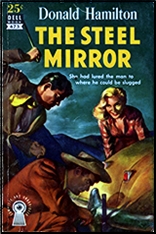
A tightly-written post-war mystery with the times reflected in small details and a plot that kept surprising me right to the end.
Even without the surprises, this would be a fun piece of nostalgia, but Steel Mirror hooks the reader quickly with John Emmett, vacationing everyman, whose car breaks down somewhere west of nowhere. He gets a ride from Anne Nicholson, an attractive, well-dressed young woman in a new car, driving across the country, and congratulates himself on his good fortune.
Until he stows his gear in the trunk and sees no luggage….
Hamilton builds nicely from this. Our hero and the young lady without luggage are being followed… by what turns out to be her Doctor and a nurse. It seems Anne worked with the French Resistance in WWII, got captured and tortured by the Gestapo – and may have betrayed her husband and friends; she can’t remember, and she’s driving across country to meet the one man who can tell her.
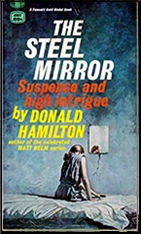
And oh yes: the good Doctor adds that she’s subject to mental breakdowns, has tried to kill herself, doesn’t trust him (the Doc) and it would be a big help to everyone if Emmett would stay with her and check in when she gets where she’s going.
Okay at this point the savvy reader has spotted the Bad Guy, and as the pages turn will guess the truth about the one man we’re after. This is because Donald Hamilton has let us spot and let us guess; this plot has more twists than a box of candy canes — near-arrest by a county sheriff, a visit from the FBI, and a helpful passer-by packing heat—and it soon occurs to Emmett and that savvy reader I mentioned that there are a lot of people who don’t want Anne to get where she’s going.
Eventually the journey reaches that point where all thrillers must inevitably arrive — Anne & Emmett on the run from a Murder charge, posing as husband & wife till they can get to the one man who can clear the whole thing up for them — whereupon it simply takes another turn and then another, all predicated on the people acting like grown-ups and not like characters in a paperback. Even when the chips are down and guns drawn there’s none of the “Very clever, Mr. Bond!” stuff, just everyone playing their cards close to the vest and me trying to figure out who’s got the Joker.
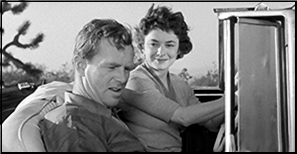
But what I shall remember from The Steel Mirror is an underlying theme of characters trying to define themselves. Emmett spent the War in a vital civilian job and he’s always wondered if he did it from convenience or cowardice. Anne is trying to find out if she’s a heroine or a traitor. And The Steel Mirror resolves both issues by letting the characters grow and understand each other.
Nice job, that.
I only started reading Donald Hamilton in the last few years. I was always put off by the Matt Helm thing, but he did some decent stuff. Like the novel basis of The Big Country and The Violent Men, and in between those two fine Westerns, Henry S. Kesler made a modest little film from this.
Kesler is hardly a name to conjure with, but he worked on some memorable films (5 Graves to Cairo, In a Lonely Place, Lured …) and Five Steps to Danger is competently done. Even quite good at times. Stars Ruth Roman and Sterling Hayden play well off each other, and the bad guys (Werner Klemperer and Richard Gaines) strike just the right note of stuffy disdain: not so much evil as arrogant, and it works well here. If you ever met a doctor too interested in himself to listen to you, then you know Klemperer’s character. And Richard Gaines (the Insurance Executive in Double Indemnity) as a duplicitous dean is so politely unhelpful as to seem maddeningly sinister.
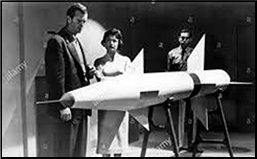
That’s director Kesler. Writer Kesler simplifies and updates Hamilton’s book. Maybe too much so. No more Gestapo. Now Anne has (or had) a brother in East Germany working against the communists who died trying to get valuable information to a German Rocket Scientist, now working for the U.S., who was an old friend of the family before the war, and it’s up to Anne to complete the mission.
Rocket Science. I wonder how long it took to think that one up? Kesler treats it more seriously than it deserves, and maybe I’m being too hard on him. If I hadn’t read the book first, I might have thought more highly of this. But I remembered the human element in the book, and I missed it in the movie.
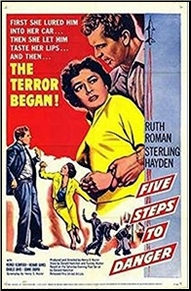
August 26th, 2019 at 1:13 pm
I remember Henry S. Kesler from many ZIV TV series of the ’50s, in particular Science Fiction Theatre and I Led Three Lives.
I’ll make the guess that the anti-Communist thread in this film is not entirely coincidental.
August 26th, 2019 at 4:48 pm
I read this one decades ago, when Hamilton’s Fawcett Gold Medal novels were on every drug store, newsstand, and bus station paperback rack. The first half-dozen or so Matt Helm books were as tight and closely plotted as anything Hamilton wrote, and although I stuck with the series for several years, the entries became more and more padded and predictable. You could rest assured that at some point in the narrative, Helm would complain about women wearing slacks.
August 26th, 2019 at 5:13 pm
Fred
My opinion of the Helm series as well. I don’t know exactly when the tipping point occurred, but padded and predictable certainly describes the books sometime well before the series ended.
But the early ones — when they were good, which was often — they were very good indeed.
August 26th, 2019 at 7:02 pm
The movie convinced me to read the book and I discovered there was more to Hamilton than Matt Helm who I have limited appreciation of. For that I owe the movie gratitude, without it and THE VIOLENT MEN I would never have read Hamilton’s Westerns or non series suspense novels and discovered how good he was.